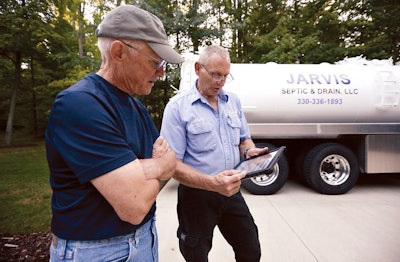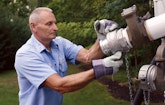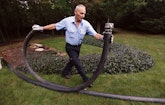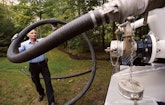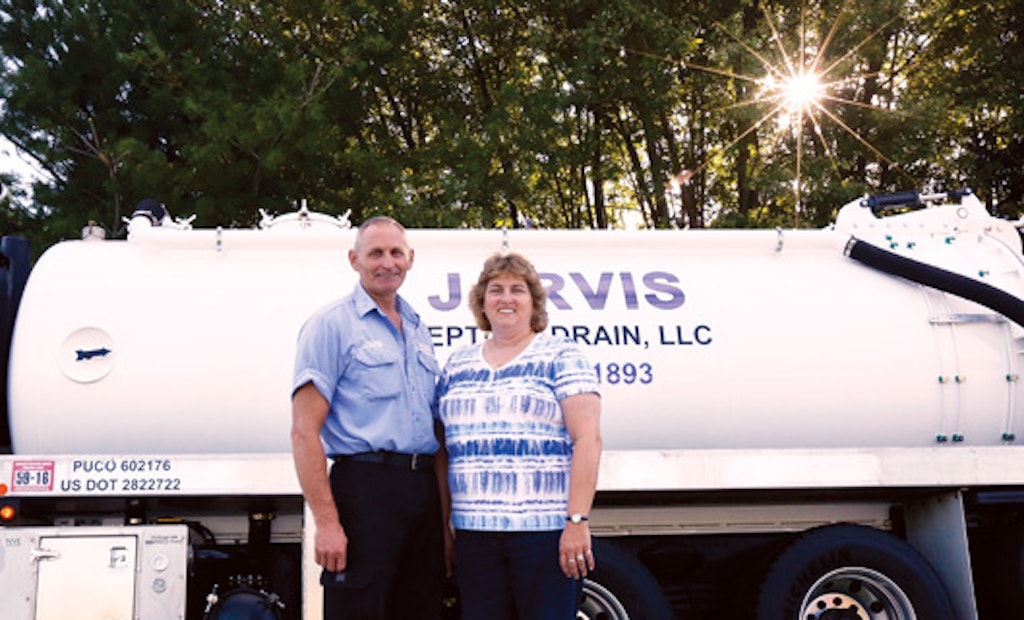Interested in Pumps?
Get Pumps articles, news and videos right in your inbox! Sign up now.
Pumps + Get AlertsAs Gene Morris celebrates both his 55th birthday and the 25th anniversary of his company, Jarvis Septic & Drain, he’s beginning to think about a future for the business that doesn’t include him or his wife, Kathy, his co-owner. “I’m thinking about an exit strategy,” he says. “I personally don’t think 10 or 12 years is too early to start thinking about it.”
Morris is actually in the identical position his predecessor, Noble Jarvis, was in 25 years ago. Jarvis started the company in 1961, ran it on his own for 31 years, then got out of it by selling to Morris.
The Morrises also run the business on their own, operating out of their 25-acre property in Seville, Ohio. Kathy handles the office work while Gene works in the field. In an emergency he can call on a nephew, brother-in-law or friend for backup help. Morris likes to stay within a 20-mile radius but says the profit is in that first 10 miles.
THE COMPANY’S FIRST TRANSITION
Morris got started in the septic industry right out of high school when he went to work for a pumper in 1981. He stayed about five years, tried another pumper for a few years, then returned to the first company. He experienced some frustrations along the way and started to get the idea that maybe he could do things a little better.
“There were too many years of shaking your head and thinking why did the boss do it that way,” he says. “If I was the boss I’d do it this way. The time came to put up or shut up.” Morris had a good relationship with Jarvis, as they were both in the industry and went to the same church. Morris knew Jarvis was getting to a retirement age, and told him to get in touch when he was ready to sell. “In 1992 he called me up and that’s where it started,” he says.
Morris says the transition was seamless for the customers, as he and Jarvis not only had the same “treat the customer right” philosophy, but even had similar mannerisms. Other than Jarvis introducing Morris to the major commercial accounts and smoothing things over with a couple of elderly women who were afraid to let Morris in the house, the hand-off was quick and painless for everyone involved.
Morris pretty much ran the business the same way Jarvis had, always keeping Jarvis’s high standards in mind. But he did eventually branch out from just doing septic pumping and today, when he’s not running his vacuum truck you’ll find him operating out of a van full of drain cleaning and pipe repair equipment.
THE VACUUM TRUCK
About 65 percent of the company’s work is pumping of one kind or another, whether it’s residential septic tanks, restaurant grease traps, commercial plants, municipal catch basins and treatment plants, lift stations, or light industrial projects. Morris is licensed to dispose of septage at several wastewater treatment facilities, including one that takes grease.
In December 2015, for only the second time in his career, Morris sold his vacuum truck and bought a new one, a 2016 Western Star 4900 SF built out by Ohio-based Tiger General. It has a 4,000-gallon steel tank, a three-stage hydraulic hoist assembly, a full-opening rear door and a National Vacuum Equipment 4310 blower. He wanted a blower because he thought it would work better for some of his tougher jobs such as catch basin clean-outs. He also noticed the blowers at some of the sewage treatment plants, which run 24/7, were still going strong after 20 years — “So, I’m hoping the durability and reliability is going to be there,” he says.
Customers are encouraged to sign up for a service reminder, but even if they don’t, Kathy contacts them every couple years if she hasn’t heard from them. Jarvis was an early adopter of technology and started automating customer records in 1985. The Morrises used his system until March 2016 when they purchased Smart Service from My Service Depot, a dispatching software program that links with their QuickBooks program.
After an initial painstaking effort of importing job and client data into the new program, and a lot of work by Kathy to create custom PDF files, the system has been a tremendous timesaver. With a few clicks on his iPad, Morris can send an invoice to a client while he’s standing with them in their driveway. It also automatically fills out parts of the forms he’s required to send to the state and counties on every pumping job, then he easily fills out the rest using drop-down boxes.
They also use the system for scheduling. Kathy enters the job information, which then shows up on Morris’ iPad along with the customer’s history. Last-minute jobs are automatically added as the system refreshes.
Regulations affecting homeowner septic systems are always being discussed by governmental agencies. An adjacent county is establishing a required maintenance program. Morris is in favor of regulations but does not like this approach. “I think the state and environment and everything would benefit more on a mandatory pumping program than a forced maintenance program,” he says. The difference is who ends up being the bad guy, he says. In other words, is it going to be the county or the pumper who has to tell the homeowner their system needs pumping or replacing?
THE SERVICE VAN
Nonpumping work is done out of the company’s 2012 Ford Econoline E350 one-ton van. Services include sewer drain cleaning for residential, commercial and light industrial customers, video camera work, electronic locating, and installation of aerators and sump pumps. Morris is also trained and licensed to make up to 4-foot repairs on 3-inch, 4-inch and 6-inch sewer lines using cured-in-place PipePatch from Source One Environmental.
Morris says a tremendous amount of his work comes from contractor referrals — plumbers who can’t or don’t want to handle drain problems, and excavators and installers who need locating services.
Equipment includes a RIDGID SeeSnake Plus 325-foot self-leveling color video camera unit, a RIDGID SeeSnake nanoReel camera for smaller lines, and a RIDGID Scout locator. Morris uses a Landa 4,000 psi hot-water pressure washer and a 300-foot 1/4-inch hose wrapped on a General Pipe Cleaners reel for thawing frozen lines. Larger sewer lines are cleared using an Electric Eel Model C with 300 feet of 1 1/4-inch cable. He also has a RIDGID K60 that runs 7/8-inch and 5/8-inch cable, and a hand-held Electric Eel Model S with 1/4-inch cable for bathroom sinks and tubs.
CUSTOMER SERVICE
Morris has a strong opinion about how to get and keep customers, and it doesn’t involve trying to be the cheapest guy in town. Instead he talks about perceived value — the customer feeling they received good value for their dollar. “And it’s treating the customers like you wish to be treated in your own home,” he says. He shows up to jobs on time, looks clean and acts professional.
“No matter how bad of a day I’m having I never let the customer see that,” he says. “I always smile and put my best foot forward.” He always tries to do the best job possible, cleans up his messes, makes a point of not overbooking, and calls if he’s going to be late. “People are a lot less unhappy if you tell them you can’t get there than promising them something and not showing up.”
In the beginning he tried to be available 24/7, but that was not sustainable. However, he does check his voice messages and will respond to true emergencies.
Jarvis Septic doesn’t advertise much. They have a small ad in the phone book, but mostly rely on word-of-mouth and contractor referrals. “If you treat the customers with respect and do the best job possible you’re going to get the referrals and you’re going to stay busy,” he says.
THE NEXT TRANSITION
As they think about retirement, the couple is taking a look at all angles and options.
“We’re trying to decide where we need to go, how we need to position the business, and what it’s going to take to get out of it and on with the retirement years,” Morris says. “It’s just a matter of trying to determine if it’s going to be a viable business to sell or if it’s just going to be a matter of liquidating the equipment and closing the door. I hope that’s not the case.”
No ideas are off the table, but some scenarios might be more complicated than others. For example, Morris believes that to attract an investor rather than an owner-operator they’d probably have to have employees, which they don’t necessarily want to do. On the other hand, having employees would present another possibility — “At that point we may be able to just keep going beyond our target retirement age and just cut our hours back.” He also says they have a couple of customers in the trucking industry who might consider taking it on.
Perhaps the ideal scenario would be the same one he was presented with when he had the chance to buy the business — someone with a similar work ethic and customer service philosophy who’s interested in operating it themselves.
“To the right person who’s willing to learn the business and work hard it’s a very good income, a good living,” he says. “But it takes the right person.”
IT WAS FUN
Overall, Morris has enjoyed being his own boss and working in an industry where he can get out, meet people and provide a good service. “I don’t think I could do something like work on an assembly line,” he says. “I enjoy the job being complete at the end of the day and the customer being happy with the work you’ve done. That’s the most rewarding part.”
The question now is how to pass the baton while ensuring his customers continue to get the great service they’re used to. “That’s the biggest thing on our minds, is how do we get out,” he says.
Fun with drones
When Gene Morris, owner, along with his wife, Kathy, of Jarvis Septic & Drain, wanted to show off his new vacuum truck, he posted a video of it on his personal YouTube page. But the most remarkable thing about the video was the device it was taken with — a DJI Phantom 3 four-propeller drone. “It took a 360-degree overhead view circling the truck,” Morris says. The Morrises bought the drone as a Christmas present to themselves last year.
The unit is roughly 18 inches across and 8 inches high. It has a built-in GPS, and the operating instructions recommend flying it in GPS mode, although Morris says it does have advanced modes for more skilled pilots. He says it’s very user-friendly to operate, somewhat like flying a fancy model airplane.
But the main difference, besides having a camera, is it comes with some pretty hefty Federal Aviation Administration regulations, which are constantly evolving as the units become more popular. He registered the drone with the FAA and uses it strictly for fun. He cautions that using it for commercial purposes puts it in a whole other category of regulations.
“The FAA has all kinds of regulations if you’re using them commercially,” he says. “As long as you’re using it for personal use and not for commercial or for-profit, you don’t have to have a license to fly it. It’s very similar to a pilot’s license, from what I understand, to use it commercially.”
The Morrises live on a 25-acre property, so they have plenty of room to enjoy the drone recreationally. But weather conditions have to be just right, Morris says. “It’s not good in the cold or if it’s too windy. There’s just a few ideal days out of the year — and it seems when there’s days there’s no time, and when there’s time the weather’s not conducive.”
To view the drone video of the Jarvis Septic truck, go to www.youtube.com/watch?v=5ARM0hBhXec.
